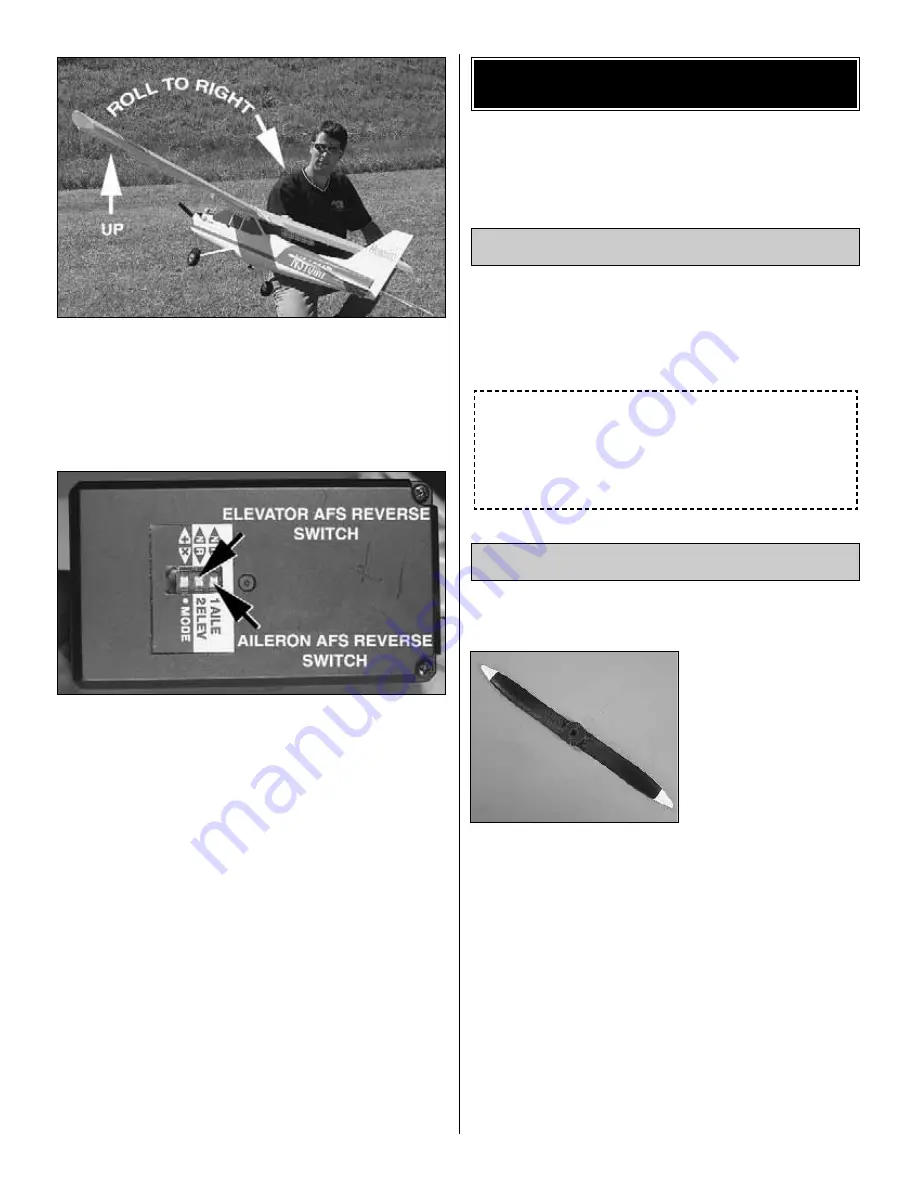
❏
5. With the airplane level, point the left wing up. The left
aileron should move up and the right aileron should
move down.
The amount of correction the AFS will induce on your
servos will depend on the gain setting of the unit. The higher
the gain, the larger the correction.
If any of the corrections made by the AFS are in the wrong
direction, you will need to reverse the correction direction
using the corresponding reversing switches on the AFS
module.
Note: While the airplane is on the ground, the shadows
underneath it will cause the AFS to add corrections to the
control surfaces. As you taxi, these corrections will change.
This is normal and it does not cause any undesired
performance from the airplane. Do your normal taxiing and
take off routine. As the airplane takes off, those corrections
due to the airplane's shadow will go away and the AFS will
resume normal operation. Again, those corrections do not
cause any irregular, unexpected or undesired take off or
landing performance.
Note: Because of the sensing characteristics of the AFS
sensor, in bright light days the unit may have a slight
tendency to trim the airplane to fly towards the sun. This
tendency normally amounts to one or two clicks of aileron
trim into the sun. This is normal and you should not worry
about it unless it becomes excessive in which case you
should land and wait for the conditions to change or
disconnect the AFS unit.
If you haven't already done so, refer to the Futaba
instruction manual for the radio control system and charge
the batteries in the plane and in the transmitter overnight
the night before you go flying.
In addition the equipment required to fuel and start the
engine mentioned near the beginning of the manual, you
should start a collection of tools that may be required for
adjustments and maintenance at the flying field. Following is
a list of the most important items.
Glow plug (OS #8 recommended - OSMG2691)
Propeller (HCAA3744)
Selecting the correct
propeller for an airplane is
very important.
Your
NexSTAR Select comes
equipped with a specially
designed nylon 11x5
propeller (HCAA3744) with
painted tips. These are the
features explained:
The painted tips are a safety
feature that will help you see the propeller arc as the engine is
running. Keep away from the propeller while the engine is
running. This engine is powerful enough to cause damage if
anything (including you) gets in the propeller arc.
The propeller is made out of flexible nylon so that it won't break
on light contact with the runway or weeds. If the propeller ever
gets in contact with anything while the engine is running,
inspect it before running it again. Check for cracks, scuffled tips
or unbalanced blades. If necessary, replace the propeller.
The Hobbico NexSTAR Select was designed around an
11x5 propeller for best performance. The 11x5 propeller
helps keep the airplane speed down at full throttle; it
increases take off performance on any surface, including tall
grass; and it acts as a brake when the nose is pointed down.
Should you ever need to replace the propeller, replace it
with the same or similar 11x5 propeller. There is no benefit
to using a larger propeller or one with more pitch.
Spare Parts
1 Medium (#1) Phillips
Screwdriver
1 Medium (#1) Flat
Screwdriver
1 5/16" (or 8mm) Socket
Wrench (for glow plug)
1 7/16" (or 11mm) Wrench
or crescent wrench (for
propeller nut)
Gather your Tools
FINAL PREPARATIONS
19
Summary of Contents for Nexstar select
Page 28: ...28 Correct Angle Rods Fin ...










































